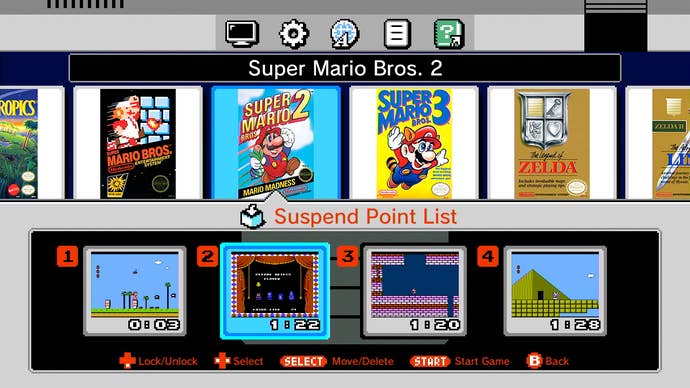NES Classic Edition Hands-On Impression: Big on Fun, Light on Features
Nintendo's mini console certainly does what it's supposed to, but not much else.
This article first appeared on USgamer, a partner publication of VG247. Some content, such as this article, has been migrated to VG247 for posterity after USgamer's closure - but it has not been edited or further vetted by the VG247 team.
15 years ago, the mall I worked in housed a kiosk that sold plug-and-play mini consoles pre-loaded with dozens of NES games. In an era before the Wii's Virtual Console, I could only think "Nintendo should really make and market their own version of this—they'd make millions!"
It took nearly two decades, but we finally have Nintendo's official take on those popular pirate boxes. And, by all accounts, it's a pretty good deal: Considering how much Nintendo charges for NES games on the Wii, 3DS, and Wii U storefronts, $59.99 for 30 games stands as a 60% discount. (If you ignore the fact that anyone with the slightest degree of technical know-how has been downloading and playing these games at no cost for the last 20 years.)

I recently had some hands-on experience with Nintendo's upcoming NES Classic Edition—available November 11th—and, as I expected, it does exactly what it's supposed to. While I couldn't get any specific tech details from the Nintendo of America reps hosting my demo session, the NES Classic's emulation appears to be the same as what's found on the Wii, and thankfully, not the Wii U. The handful of games I played out of the 30 available worked exactly as intended, and the old-school NES gamepads added that important dose of authenticity to the experience. And if playing classic games with a non-ergonomic plastic rectangle isn't your thing, you can also plug in a Wii Pro Controller or a Wii Classic Controller.
For you retro sticklers out there, the NES Classic Edition offers four different ways to display its collection of classic games. 4:3 mode, which serves as the standard visual interpretation, Pixel Perfect mode, which, as the name implies, displays every pixel as a perfect square—as it was designed, but not necessarily as it was viewed on an old CRT television. And speaking of pre-HD TVs, the NES Classic Edition also features a CRT mode that feels just like a similar mode found in last year's Mega Man Legacy Collection with how it emulates the scan lines and foibles of an old tube television. (Though I assume most retro folks who crave authenticity have their own CRT setups at home.)
If anything, the NES Classic Edition excels in nostalgic novelty value, While it's much smaller than its big, boxy ancestor, this mini console feels solidly built, and has all the physical traits of the original Nintendo Entertainment System—minus the squeaky flip-top cover lid. But if you're expecting something more than a convenient way to play some of the best 8-bit games ever, the NES Classic Edition may have you wanting more. While the user interface and construction of the console don't feel cheap by any means, it's more than obvious that Nintendo cut every possible cost to ensure this new creation brings them a tidy profit.

If you're a big fan of Nintendo's 8-bit era, the NES Classic Edition may strike you as a startlingly barebones experience. While manuals for these games have been available with their Virtual Console editions for years now, selecting the "Manuals" option in the UI simply makes a QR code appear on your screen which links to a Nintendo-hosted site containing scanned documentation for the NES Classic Edition's 30 games. And though Nintendo could have added some sort of marketplace functionality to give the NES Classic Edition a life beyond its admittedly robust collection of games, it's strictly an offline-only console.
Granted, these are somewhat minor nitpicks, but other design choices behind the NES Classic Edition feel like genuine oversights. All of your controllers have to be plugged directly into the mini console itself, which would only be a minor annoyance if the cords on these NES gamepad replicas weren't so short. (The Nintendo reps at my session couldn't give me an exact measurement, but they seemed to be around three feet in length.) This fits in with the general sense that Nintendo wants you to keep the NES Classic Edition nearby, instead of placed across the room in an entertainment center. In order to use any of the system's core functionality, you need to first hit "reset" on the console itself, which serves as a "home" button of sorts. This would be a negligible issue if you only needed to hit reset to change games, but unfortunately, you also need to press this button to load and save from one of four states per NES game. I understand why Nintendo wants to keep the 8-bit experience as authentic as possible, but even adding a tiny "home" button to the existing NES controller's design would have been a much more player-friendly choice.

It should be noted that I co-host a retro gaming podcast, so my expectations could be a bit higher than most. But I can't help but shake the feeling the NES Classic could and should be so much more. Like Nintendo's anemic celebration of Mario's 25th anniversary—which amounted to Super Mario All-Stars being burned to a Wii disc—the NES Classic feels like a slightly cynical nostalgia cash-in done with the lowest effort possible. Again, it's a great little mini-console if you're looking for a no-frills way to play 30 great NES games, but if you've been buying and rebuying NES games on Virtual Console for the last decade, Nintendo's austere approach will leave you more than a little disappointed.
